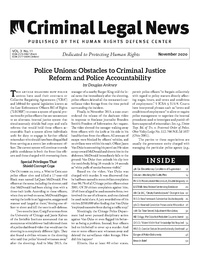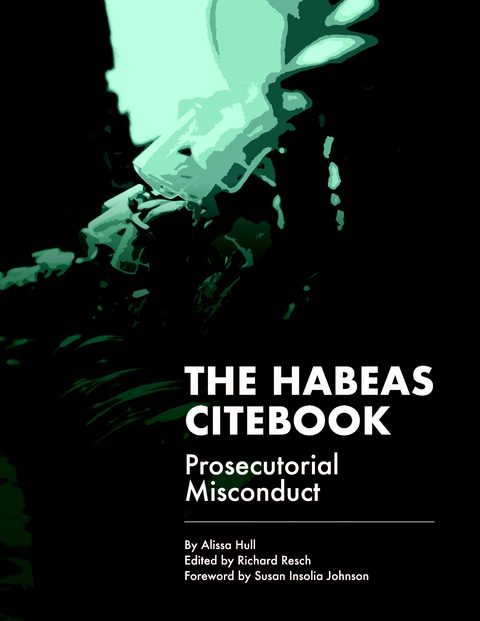by Douglas Ankney
This article examines how police unions have used their contracts or Collective Bargaining Agreements (“CBA”) and lobbied for special legislation known as the Law Enforcement Officers Bill of Rights (“LEOBR”) to create a system of special protections for police officers that are tantamount to an alternate, internal ...
by Anthony Accurso
The U.S. Court of Appeals for the Fourth Circuit reversed and remanded for resentencing a case because the U.S. District Court for the Western District of North Carolina imposed 26 conditions of supervision as part of its written order, but had made no mention of supervision conditions ...
by Casey Bastian
Jamarcus Glover was offered a plea agreement on July 13, 2020, by Commonwealth attorney Tom Wine. Glover is a convicted felon with a history of drug trafficking. The plea would reduce the likely 10-year prison sentence on charges of criminal syndication, drug trafficking, and gun charges to ...
by Dale Chappell
In this final column based on my book, WinningCites: Attacking the Guilty Plea, we’ll go over how plea waivers and breaches of plea agreements impact challenging a guilty plea, and we’ll also dig into one of the most-asked questions I hear: Can I get more time ...
by Douglas Ankney
The Supreme Court of Pennsylvania concluded that Article I, Section 10 of the Pennsylvania Constitution, prohibition against double jeopardy, bars retrial because the prosecutor’s misconduct that evinced a conscious disregard for a substantial risk of harm deprived the defendant of his right to a fair trial.
In ...
by Michael Fortino, Ph.D.
You may not remember the 1971 Stanford University Prison Experiment. Maybe you were not yet born, but the outcome of this infamous study depicted a reality where everyday people, when assigned the role of “jailer,” almost immediately morph into sadistic, power-hungry, conformists who manage to find ...
by Dale Chappell
A powerful new database combines data from multiple sources in order to provide more useful information about federal sentencing.
The ground-breaking service is a first of its kind and has been an eye-opener about what’s really going on in federal sentencing.
This new tool is called JUSTFAIR ...
by Jayson Hawkins
In most states across America, an employee can be fired at any time for any reason. Only Montana provides some protection after six months on the job; otherwise, employment in America is an “at will” affair. Unless, of course, you are a police officer, in which case ...
by Dale Chappell
The U.S. Court of Appeals for the Sixth Circuit held on August 20, 2020, that appellate counsel’s failure to raise a “clearly foreshadowed” change in decisional law that would’ve led to a likely change in the outcome was ineffective assistance of counsel (“IAC”) sufficient to excuse procedural ...
by Dale Chappell
The U.S. Court of Appeals for the Ninth Circuit held that the use of unconvicted criminal conduct that was too dissimilar to the charged offense to obtain a conviction violates a defendant’s due process rights and granted habeas corpus relief, vacating a murder conviction and death sentence. ...
by Dale Chappell
In a case where a prosecutor pulled statements from a detective during testimony before a jury that tied a defendant to the crime – and without that witness testifying in court himself – the U.S. Court of Appeals for the Fifth Circuit held that this violated the ...
by Douglas Ankney
The Supreme Court of Indiana announced a new analytical framework for reviewing claims of substantive double jeopardy, overruling Richardson v. State, 717 N.E.2d 32 (Ind. 1999).
A jury convicted Jordan Wadle of Operating a Vehicle While Intoxicated Causing Serious Bodily Injury (“OWI-SBI”), OWI Endangering a Person, ...
by Anthony Accurso
The Supreme Court of Idaho clarified the rule of evidence regarding the admissibility of prior false allegations of rape made by victims, announced a three-part test to assess the admissibility of such evidence, and vacated a defendant’s conviction.
Steven Michael Chambers was charged with raping N.S. in ...
In a recent decision dismissing a defendant’s lawsuit against a police officer on the basis of qualified immunity, Judge Carlton Reeves of Mississippi filed a 72-page opinion that challenges the morality of the doctrine of qualified immunity, provides an in-depth history of the doctrine, and concludes with a challenge to ...
by Douglas Ankney
The U.S. Court of Appeals for the Fifth Circuit reversed Thaddeus Beaulieu’s felony criminal contempt conviction based on the prosecutor’s remarks that rose to the level of prejudicial misconduct.
During an interview with FBI Agent Steven Rayes, Beaulieu identified various individuals in carjackings and bank robberies. Rayes ...
by Dale Chappell
The Supreme Court of Arizona held on September 1, 2020, that a statute increasing a misdemeanor charge to a felony for merely being part of a gang is unconstitutional on its face as a violation of substantive due process, affirming a trial court’s dismissal of the charges. ...
by Matt Clarke
On August 27, 2020, the Supreme Court of Mississippi held that a change in the guidelines of the American Board of Forensic Odontology (“ABFO”) prohibiting testimony that bite mark comparison could be used to identify an individual constituted new evidence that could be used in postconviction proceedings ...
by Anthony Accurso
The U.S. Court of Appeals for the Eighth Circuit reversed the U.S. District Court for the District of North Dakota’s denial of a defendant’s 28 U.S.C.§ 2255 motion and held counsel should have known the 21 U.S.C. § 851 enhancement should not have applied and then advised ...
by Dale Chappell
The U.S. Court of Appeals for the First Circuit held on August 3, 2020, that the U.S. District Court for the District of Puerto Rico’s focus on the dangerousness of machine guns and their link to brutal crimes in general are not permissible reasons to impose a ...
by Matt Clarke
The U.S. Court of Appeals for the Eleventh Circuit ruled U.S.S.G. § 5Gl.3(b)(l)’s “a court shall adjust the sentence” for time served on a related state crime is mandatory once the section’s requirements are met. Acknowledging a circuit split on the issue, it ruled that a § ...
by Anthony Accurso
In a decision issued on July 17, 2020, the Supreme Court of Kansas struck the residual clause of the state’s statute prohibiting possession of a knife by a convicted felon due to its definition being unconstitutionally vague.
Christopher M. Harris was a convicted felon on post-release supervision ...
by Anthony Accurso
The Court of Appeals of Maryland held that the odor of marijuana emanating from a person alone does not provide police with probable cause to support an arrest and warrantless search incident to the arrest.
Rasherd Lewis was in a convenience store in Baltimore City on February ...
by Douglas Ankney
The U.S. Court of Appeals for the Ninth Circuit ruled that the passage of eight months from the time of the unlawful seizure of Nikolay P. Bocharnikov until he gave his statement to law enforcement did not sufficiently attenuate the statement from the seizure.
In July 2017, ...
by Douglas Ankney
Division Eight of the California Court of Appeal for the Second Appellate District held that a trial court abused its discretion when it excluded evidence of a homicide victim’s prior violent acts.
Neil Efren Delrio exchanged gunfire with his cousin, Raul Prieto. According to Delrio (the only ...
by Douglas Ankney
The Supreme Court of New Jersey ruled that a defendant has a right to question a cooperating witness about a plea deal and the witness’ possible sentencing exposure before accepting that deal even if the witness’ exposure was the same as the defendant’s. At the heart of ...
by Douglas Ankney
The Supreme Court of Missouri held that a circuit court erred when it excluded testimony from Kane Carpenter’s expert witness relating to the accuracy of witness identifications.
In October 2016, a young white man (“Victim”) was approached by two black men, hoodies pulled low to cover their ...
by Anthony Accurso
The U.S. Court of Appeals for the Seventh Circuit held that a conviction under 18 U.S.C. § 2251(a) for production of child pornography cannot be sustained where the defendant only engaged in sexually explicit conduct near a minor when the images were produced.
Prior to ...
by Douglas Ankney
The Supreme Court of California reversed the murder conviction and death sentence of Paul Nathan Henderson because the police continued to question him after he made an unambiguous request for counsel.
Henderson was arrested on July 5, 1997, in connection with a home invasion of a mobile ...
by Dale Chappell
The U.S. Court of Appeals for the Fourth Circuit expanded the First Step Act’s “covered offense” for crack cocaine sentence reductions to include all of the federal statute penalizing crack cocaine offenses, even if the change would not affect the penalty range for a particular offense. As ...
by Anthony Accurso
The Supreme Court of Wisconsin held that the Court of Appeals erred when it affirmed the denial of a suppression motion because officers were not acting in their role as “community caretakers” when they inventoried a defendant’s vehicle for towing following a traffic stop.
Alfonso Lorenzo Brooks ...
by David M. Reutter
The U.S. Circuit Court of Appeals for the Sixth Circuit held that Michigan courts unreasonably applied clearly established federal law by allowing a defendant’s appellate counsel to withdraw and failing to appoint replacement counsel. The Court ordered a new first-tier appeal in Michigan courts.
The Court’s ...
by Anthony Accurso
The U.S. Court of Appeals for the Sixth Circuit clarified that the term “different location” in the U.S. Sentencing Guidelines commentary definition of “abduction” requires more movement than from a sales floor of a business to the back breakroom for the related robbery enhancement to apply.
Tramain ...
by Jayson Hawkins
The walls in Alex’s home are decorated with medals earned from two tours as a Marine serving in Iraq. He returned to the U.S. in 2007 at age 21, psychologically scarred by a war that left him suffering from Post-Traumatic Stress Disorder (“PTSD”) and crippling anxiety. ...
by Anthony Accurso
In a decision issued July 22, 2020, the Supreme Court of Minnesota ruled that Minnesota Statutes Section 609.27, subd. 1(4) (2018) (“the coercion statute”) is overbroad on its face, violates the First Amendment to the U.S. Constitution, and must be struck in its entirety.
John Joseph Jorgenson ...
by Ed Lyon
In the late 1960s, a young Ohio National Guard soldier fatally wounded a person protesting the Vietnam War at Kent State University. It was not the first or the last time this would occur.
Incidents like these probably went a long way to inspiring the development of ...
by Jayson Hawkins
The murder of Ahmaud Arbery was shockingly mishandled by local police from the very beginning. Two White men chased down and shot a young Black man, and yet they had not been charged two months later, despite the fact that the whole event was caught on tape. ...
by Michael Fortino, Ph.D.
In the summer of 2020, a summer of discontent, a summer rife with pandemic lockdowns and street protests, the Georgia Legislature chose not to address the unrest and concerns of protesters but rather to double down on the side of law enforcement. They decided to give ...
by Casey Bastian
All across America, mostly peaceful protests have advanced cries to defund the police. This increasing demand is in response to too many recent examples of law enforcement abusing its authority. Often, these acts result in seemingly avoidable injuries or deaths. So some of the more liberal cities ...
by Jayson Hawkins
Police occupy a unique place in a free society. They are empowered to enforce the public will upon the very public that empowers them. They alone are entrusted with the power to use lethal force, while at the same time their safety enjoys special protection under the ...
by Jayson Hawkins
The proliferation of police procedurals over the past few decades has made virtually everyone who owns a TV familiar with the climactic scene in the interrogation room – detectives trap a suspect in a lie or inconsistency even as they lean in to physically corner the suspect. ...
by Kevin Bliss
The Narcotics Bureau (“NB”) of the Springfield Police Department (“SPD”) regularly used excessive force in the commission of its duties, covering its violations through deficiencies in its use of force reporting system.
That’s according to a report by the Civil Rights Division of the U.S. Department of ...
by Douglas Ankney
Ring is Amazon’s “smart” doorbell camera company that allows video cameras within users’ doorbells to surveil their porches, sidewalks, yards, and even the streets next to their homes. But Ring has also partnered with some law enforcement agencies, enabling police to directly email requests to Ring’s customers ...
by Casey Bastian
In 2018, Florida electors passed an amendment to the state constitution allowing the restoration of voting rights to residents convicted of felonies. The amendment, which does not apply to those convicted of murder or sexual offenses, restored the right to any resident who completed “all terms of ...
by Ed Lyon
There’s a new tool around for the old sheriff in town when it comes to dealing with peaceful protesters. This tool is called kettling, and it has nothing to do with heating water for tea, although its use has probably caused many hapless protesters to get hot ...
by Kevin Bliss
Government watchdog organizations are reporting that multiple government agencies employed high-tech surveillance aircraft over cities with demonstrations over the police killing of Minneapolis resident George Floyd.
On June 2, thousands of protestors took to the streets in major cities across the U.S. to call for an end ...
Loaded on
Oct. 15, 2020
published in Criminal Legal News
November, 2020, page 50
Alaska: Police here can fly over property but they “cannot use cameras and drones for aerial searches of property without a warrant,” the Alaska Court of Appeals ruled. “The ruling stems from a 2012 case in which Alaska State Troopers received a tip about marijuana being grown on ...






